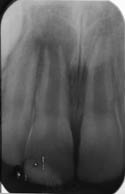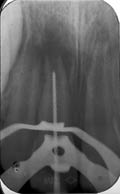(b) 
What did the radiograph (Figure 3.1.1b) reveal about the 11?
- Periapical radiolucency.
- Parallel root canal walls.
- Arrested or slower root development compared to the 21.
- Class IV restoration.
It is not uncommon for immature teeth to have periapical radiolucent areas in the region of the developing root apicies. Both central incisors had periapical radiolucencies; however, on closer inspection the radiolucent area associated with tooth 11 was larger and well defined; this was an indication that the radiolucency may be pathological rather than physiological in nature.
Diagnosis and treatment planning
What was the diagnosis and treatment plan?
The diagnosis was chronic periapical periodontitis with an abscess associated with an infected necrotic root canal. If this tooth did not have an existing periapical radiolucency, the diagnosis would have been an acute periapical abscess.
What were the potential treatment options for this patient?
- Root end closure (endodontic treatment).
- Extraction.
- Leave alone.
As with all types of endodontic treatment, the aim of root end closure is to prevent periapical periodontitis in teeth with irreversible pulpitis and to heal periapical periodontitis in teeth with infected, necrotic root canal spaces. In addition, root end closure aims to create an periapical calcific barrier in teeth with incomplete root development.
Extraction of the tooth was not a desirable option as this would have resulted in the patient being committed to prosthodontic treatment to replace the missing tooth.
Are there any specific problems in performing endodontic treatment on immature teeth?
Teeth with immature apices are more challenging to obturate as the canal may be parallel or divergent apically, thus, there is little or no resistance form to compact the root filling material against. Mechanical instrumentation to create an periapical taper of the already thin and fragile root canals is not advisable as this would further weaken an already compromised tooth.
Irrigants must be gently introduced into the root canal using pre-measured needles at least 2–3 mm short of the working length; this will prevent extrusion of irrigants into the periapical tissues.
Treatment
Endodontic treatment was carried out over two visits under local anaesthetic and rubber dam. At the first visit, an access cavity was prepared and the canal was irrigated with sodium hypochlorite using a pre-measured needle. The working length was estimated from the diagnostic radiographs and confirmed with a working length radiograph (Figure 3.1.2).
Figure 3.1.2 Working length radiograph; a cotton pellet was used to secure the endodontic file within the canal. The working length was increased by 2 mm as this radiograph revealed that the endodontic file was 3 mm short of the radiographic apex.

Pus from the abscess was drained through the root canal. After the tooth had been thoroughly drained and irrigated with copious amounts of sodium hypochlorite, the root canal was dried with paper points and dressed with a calcium hydroxide paste for 2 weeks.
What is the purpose of a calcium hydroxide inter-appointment medicament?
Calcium hydroxide has several desirable properties which are related to its high pH (12.5). These include:
Stay updated, free dental videos. Join our Telegram channel

VIDEdental - Online dental courses


